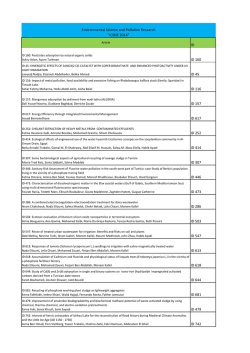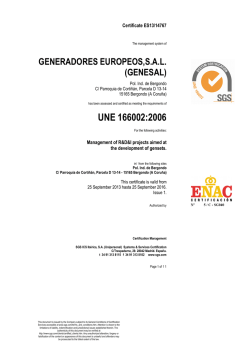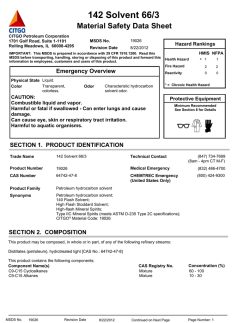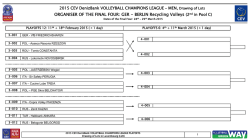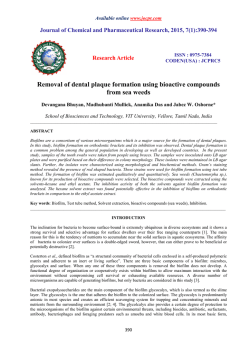
Pages: 1-12 (Download PDF) - European/American Journals
International Journal of Energy and Environmental Research Vol.3,No.1,pp.1-12, March 2015 Published by European Centre for Research Training and Development UK (www.eajournals.org) REGENERATION OF USED LUBRICATING ENGINE OIL BY SOLVENT EXTRACTION PROCESS Aremu, Mujidat Omolara1, Araromi, Dauda Olurotimi2, Gbolahan, Olujide Olatunji3 Department of Chemical Engineering, Faculty of Engineering, LadokeAkintola University of Technology P.M.B. 4000,Ogbomoso, Nigeria. ABSTRACT: The increase in the use of motor vehicles has resulted to generation of large quantity of used lubricating engine oil which is being disposed improperly, thereby leading to environmental pollution. This work therefore investigated solvent extraction process for recycling of used lubricating engine oil. Three solvents: 1-butanol, 2-propanol and mixtures of 1-butanol-ethanol were considered. Each solvent was used to segregate impurities in the form of sludge at different extraction factors considered.The performances of the solvents were investigated by determination of Percent Sludge Removal and Percent Oil Loss. The investigation revealed that 1-butanol produced the best extraction performance. KEYWORDS: Extraction, Contact time, Oil loss, Recycling, Sludge INTRODUCTION Lubricating oils are viscous fluids used to facilitate relative motion of solid bodies by minimising friction and wear between interacting surfaces. The largest application is to protect the internal combustion engines in motor vehicles and powered equipment (Boyde, 2002). Typical lubricating oil contains ninety percent base oil, most often petroleum fractions called mineral oils and less than ten percent additives. The chemical breakdown of these additives during use resulted to build up of halogenated hydrocarbons in the oil. Polycyclic aromatic hydrocarbons (PAHs) as well as other polycyclic compounds are generated and accumulate in the oil (Wong and Wang, 2001) together with metals from wear and tear of the engine being lubricated (Chung et al., 2007). These compounds gradually reduced its quality leading to change in its physical and chemical properties and thereby deteriorated (Bridjanian, 2006). These components are highly toxic upon released to the environment posing harmful effects to aquatic lives and human beings (Kanokkantapongaet al., 2009). The improper disposal of used lubricating oil pollutes environment to a great extent as each volume of it can pollute not less than two hundred and fifty thousand volumes of water (Bridjanian, 2006). Proper management of this hazardous material is therefore important in order to make it a valuable product by greatly reducing the quantity being disposed improperly (Dang, 2006). Therefore re-refining of used lubricating oil will eliminates the environmental threats posed and preserves crude oil reserves (Duraniet al., 2010). Several techniques are available for the regeneration of used lubricating oil, among which are chemical treatment (Rahmanet al., 2008; Hani and Alwedyan, 2012), acid activated process that is similar to acid-clay process with little modification (Liu et al., 2005), physical treatment by distillation and thin film evaporation (Brinkman et al., 1981) and solvent extraction (Katiyar and Husain 2010). However solvent extraction treatment has rectified some of shortcomings likeacid sludge generation and its disposal, lower yield and loss of oil in sludge that are created by other methods (Shakirullahet 1 ISSN 2055-0197(Print), ISSN 2055-0200(Online) International Journal of Energy and Environmental Research Vol.3,No.1,pp.1-12, March 2015 Published by European Centre for Research Training and Development UK (www.eajournals.org) al., 2006). Nimiret al., (1997) and Durani et al., (2012) worked on used lubricating oil recycling using 1-butanol, methyl ethyl ketone (MEK) and 2-propanol as different solvents. Durani et al., 2010 researched on re-refining of used lubricating oil by solvent extraction using composite solvents (2-propanol, 1-butanol and butanone) to investigate extraction temperature and solvent to oil ratio. In this work, performance of solvent extraction process using both pure solvent and composite solvent was evaluated for different solvent to oil ratio, temperature and contact time.The performance of the process was measured through two dependent variables, the Percent Sludge Removal (PSR) and Percent Oil Loss (POL) (Durani et al., 2010). Experimental The used lubricating engine oil (W) was collected from motor vehicle service stations. Collected oils were mixed together to represent a complete spectrum of used lubricating engine oil. Pre-treatment of the oil involved removal of solid particles by gravity settling. The oil was heated at 140°C and atmospheric pressure for 1 hour to remove residual free and emulsified water (Hani et al., 2010). Mixtures were prepared in different ratios from 1:1 to 6:1, by weight of solvent (1-butanol, 2-propanol and mixture of 1-butanol and ethanol) and used lubricating oil. Each system was homogenized at 300 rpm for 30 minutes and placed in water bath for 20 minutes to maintain a constant temperature at 35oC. It was allowed to stand for 24 hours. Biphasic system, the extract phase and wet sludge (W1), was formed. The same procedure was carried out for 30 minutes of contact time at 35oC. The procedure was repeated for 20 minutes at 45oC, 30 minutes at 45oC, 20 minutes at 50oC, and 30 minutes at 50oC. The following responses were considered for determining the effectiveness of the process Percent Sludge Removal and Percent Oil Loss The oil losses to the sludge was determine by addition of n-hexane to W1 followed by 2propanol. This resulted to formation of gel and the gel was left for 12 hours to settle under gravity to allow for sludge formation (Nimiret al., 1997; Durani et al., 2010). The biphasic system was separated by using vacuum distillation (Nimiret al., 1999; Hani et al., 2010; Durani et al., 2010). The washed sludge was oven dried at 100oC for 15 minutes and cooled to room temperature (Nimiret al., 1997; Durani et al., 2012). The PSR and POL, oil in sludge phase per 100 grams of used lubricating engine oil were calculated using the equation (1) and (2) below respectively (Nimiret al.; Durani et al., 2012). 𝑊 𝑃𝑆𝑅 = 𝑊2 × 100% (1) 𝑃𝑂𝐿 = 𝑊1 −𝑊2 𝑊 × 100% (2) RESULTS AND DISCUSSION Figure 1- 2 show the plot of Percent sludge removal (PSR) against solvent to oil ratio (SOR) at 20 and 30 minutes of contact times, respectively using 1-butanol, 2-propanol; mixture of 1butanol and ethanol as solvents at extraction temperature 35, 45 and 50oC. As observed from the Figures, PSR increased in an exponential decay manner with increase in SOR. This implies that there is a limit to which solvent can be increased to improve sludge removal for a particular temperature. This is in agreement with the result obtained by Nimiret al., (1997), and Duraniet al., (2012). However, increase in temperature improved PSR as can be observed from the Figures. 2 ISSN 2055-0197(Print), ISSN 2055-0200(Online) International Journal of Energy and Environmental Research Vol.3,No.1,pp.1-12, March 2015 Published by European Centre for Research Training and Development UK (www.eajournals.org) 1-Butanol 35oC 1-Butanol+Ethanol 35oC 2-Propanol 45oC 1-Butanol 50oC 1-Butanol+Ethanol 50oC 2-Propanol 35oC 1-Butanol 45oC 1-Butanol+Ethanol 45oC 2-Propanol 50oC 14 Percent Sludge Removal (%) 12 10 8 6 4 2 0 1:1 2:1 3:1 4:1 5:1 6:1 Solvent Oil ratio Figure 1: Percent Sludge Removal curves for different Solvents used at different temperatures and contact time of 20 minutes 1-Butanol 35oc 1-Butanol+Ethanol 35oC 2-Propanol 45oC 1-Butanol 50oc 1-Butanol+Ethanol 50oC 2-Propanol 35oC 1-Butanol 45oC 1-Butanol+Ethanol 45oC 2-Propanol 50oC 14 Percent Sludge Removal (%) 12 10 8 6 4 2 0 1:1 2:1 3:1 4:1 5:1 6:1 Solvent Oil Ratio Figure 2: Percent Sludge Removal curves for different Solvents used at different temperatures and contact time of 30 minutes Figure 3- 4 show the plots of percent oil loss (POL) against solvent to oil ratio. The Figures show that POL decreased with the extraction temperature and there exit a limit to which increase in SOR can improve reduction in POL. The Figures show that 1-butanol gave the least POL at extraction temperature 45oC at all contact time follow by 2-propanol and mixture of 1butanol and ethanol. This is in close agreement with the result presented by Al-Zahraniet al., (2012). 3 ISSN 2055-0197(Print), ISSN 2055-0200(Online) International Journal of Energy and Environmental Research Vol.3,No.1,pp.1-12, March 2015 Published by European Centre for Research Training and Development UK (www.eajournals.org) 1-Butanol 35oC 1-Butanol+Ethanol 35oC 2-Propanol 45oC 1-Butanol 50oC 1-Butanol+Ethanol 50oC 2-Propanol 35oC 1-Butanol 45oC 1-Butanol+Ethanol 45oC 2-Propanol 50oC 20 18 16 Percent Oil Loss (%) 14 12 10 8 6 4 2 0 1:1 2:1 3:1 4:1 5:1 6:1 Solvent Oil Ratio Figure 3: Percent Oil Loss curves for different Solvents used at different temperatures and contact time of 20 minutes 1-Butanol 35oC 1-Butanol+Ethanol 35oc 2-Propanol 45oc 1-Butanol 50oc 1-Butanol+Ethanol 50oC 2-Propanol 35oc 1-Butanol 45oc 1-Butanol+Ethanol 45oc 2-Propanol 50oc 20 18 16 Percent Oil Loss 14 12 10 8 6 4 2 0 1:1 2:1 3:1 4:1 5:1 6:1 Solvent Oil Ratio Figure 4: Percent Oil Loss curves for different Solvents used at different temperatures and contact time of 30 minutes Figures 5- 10 show the effect of solvents to oil ratio on the PSR at extraction temperatures 35oC, 45oC and 50oC for 20 and 30 minutes of contact time, respectively. In Figure 5 using 1butanol at extraction temperature 35oC, it was observed that there were quick rise in amount of PSR at SOR between 1:1 and 1.9:1. The increase in amount of PSR was gradual at SOR in between 2:1 and 2.8:1. At higher ratio the curves show a retreating effect instead of further increase in PSR as SOR is increasing. Considering SOR 4:1 and 6:1 at temperature 50oC, 12.1 and 12.5 are the PSR respectively. The maximum PSR at 35oC was 10.7 and 11.5 at 50oC for contact time of 20 minutes. In Figure 6, 1-butanol as solvent at extraction temperature 45oC 4 ISSN 2055-0197(Print), ISSN 2055-0200(Online) International Journal of Energy and Environmental Research Vol.3,No.1,pp.1-12, March 2015 Published by European Centre for Research Training and Development UK (www.eajournals.org) and 50oC, the PSR were 11.4 and 11.9, respectively at the same SOR 6:1 and contact time of 30 minutes. Similar trends were observed for other solvents. 1-Butanol 35oC 50oC 45oC 14 Percent sludge Removal (%) 12 10 8 6 4 2 0 1:1 2:1 3:1 4:1 5:1 6:1 Solvent Oil Ratio Figure 5: Percent Sludge Removal curves for a system of 1-Butanol and ULEO at three temperatures and contact time of 20 minutes 35oC 1-Butanol 45oC 50oc 14 Percent Sludge Removal (%) 12 10 8 6 4 2 0 1:1 2:1 3:1 4:1 5:1 6:1 Solvent Oil Ratio Figure 6: Percent Sludge Removal curves for a system of 1-Butanol and ULEO at three temperatures and at contact time 30 minutes 5 ISSN 2055-0197(Print), ISSN 2055-0200(Online) International Journal of Energy and Environmental Research Vol.3,No.1,pp.1-12, March 2015 Published by European Centre for Research Training and Development UK (www.eajournals.org) 2-Propanol 35oC 45oC 50oC 10 9 Percent Sludge removal (%) 8 7 6 5 4 3 2 1 0 1:1 2:1 3:1 4:1 5:1 6:1 Solvent Oil Ratio Figure 7: Percent Sludge Removal curves for a system of 2-Propanol and ULEO at three temperatures and at contact time 20 minutes 35oC 2-Propanol 45oc 50oC 12 Percent Sludge Removal (%) 10 8 6 4 2 0 1:1 2:1 3:1 Solvent 4:1 Oil 5:1 6:1 ratio Figure 8: Percent Sludge Removal curves for a system of 2-Propanol and ULEO at three temperatures and at contact time 30 minutes 1-Butanol+Ethanol 35oC 45oC 50oC 10 9 Percent sludge Removal (%) 8 7 6 5 4 3 2 1 0 1:1 2:1 3:1 4:1 5:1 6:1 Solvent Oil Ratio Figure 9: Percent Sludge Removal curves for a system of mixture of 1-Butanol, ethanol and ULEO at three temperatures and at contact time 20 minutes 6 ISSN 2055-0197(Print), ISSN 2055-0200(Online) International Journal of Energy and Environmental Research Vol.3,No.1,pp.1-12, March 2015 Published by European Centre for Research Training and Development UK (www.eajournals.org) 1-Butanol+Ethanol 35oc 45oc 50oC 10 9 Percent Sludgr Removal (%) 8 7 6 5 4 3 2 1 0 1:1 2:1 3:1 4:1 5:1 6:1 Solve nt Oil Ra tio Figure 10: Percent Sludge Removal curves for a system of mixture of 1-Butanol, ethanol and ULEO at three temperatures and at contact time 30 minutes Figures 11 - 16 are plots of the effect of SOR on POL at extraction temperature 35oC,45oC and 50oC for 20 and 30 minutes of contact times, respectively. The Figures shows that there were decrease in POL despite increase in solvent to oil ratio. It is shown in the Figures that there was a rapid reduction in POL amount at SOR between 1:1 and 2:1. The POL continued to drop between SOR 2:1 and 2.8:1. However, at higher SOR, a retreating effect was observed. This shows that a limit there exist beyond which improvement in decrease in POL cannot be achieved with increase in SOR. These sections revealed the region to obtain the minimum oil losses in the sludge at a specified extraction temperature (Nimiret al., 1997). Figure 11 shows that at extraction temperature 30oC and 50oC; SOR (2:1), the POL were 13.9 and 14.1 for 20 minutes of contact time respectively. At extraction temperature 45oC and 50oC; SOR (6:1), the POL were 10.4 and 10.9, respectively for the same contact time. Similar trends were observed from other Figures for POL. Other solvents gave similar trends for both PSR and POL. These results are in close agreement with the PSR and POL result reported by Duraniet al., (2012) andAl-Zahrani, et al., (2012). It was observed that extraction temperature has slight effect on both PSR and POL. Increase in extraction temperature and SOR resulted to increase in PSR but a decrease in POL. There is need to increase PSR and decrease POL, therefore varying temperature has slight effect on improving the performance of the process since similar effects were displayed at specified temperature. 7 ISSN 2055-0197(Print), ISSN 2055-0200(Online) International Journal of Energy and Environmental Research Vol.3,No.1,pp.1-12, March 2015 Published by European Centre for Research Training and Development UK (www.eajournals.org) 1-Butanol 35oC 45oC 50oc 18 16 Percent oil Loss (%) 14 12 10 8 6 4 2 0 1:1 2:1 3:1 4:1 5:1 6:1 Solvent Oil Ratio Figure 11: Percent Oil Loss curves for a system of 1-Butanol and ULEO at three temperatures and at contact time of 20 minutes 35oC 1-Butanol 45oC 50oC 18 16 Percent Oil Loss (%) 14 12 10 8 6 4 2 0 1:1 2:1 3:1 4:1 5:1 6:1 Solvent Oil Ratio Figure 12: Percent Oil Loss curves for a system of 1-Butanol and ULEO at three temperatures and at contact time of 30 minutes 35oC 2-Propanol 45oC 50oc 16 14 Percent Oil Loss (%) 12 10 8 6 4 2 0 1:1 2:1 3:1 4:1 5:1 6:1 Solvent Oil Ratio Figure 13: Percent Oil Loss curves for a system of 2-Propanol and ULEO at three temperatures and at contact time of 20 minutes 8 ISSN 2055-0197(Print), ISSN 2055-0200(Online) International Journal of Energy and Environmental Research Vol.3,No.1,pp.1-12, March 2015 Published by European Centre for Research Training and Development UK (www.eajournals.org) 2-Propanol 35oC 45oc 50oC 18 16 Percent Sludge Removal (%) 14 12 10 8 6 4 2 0 1:1 2:1 3:1 4:1 5:1 6:1 Solvent Oil ratio Figure 14: Percent Oil Loss curves for a system of 2-Propanol and ULEO at three temperatures and at contact time of 30 minutes 1-Butanol+Ethanol 35oC 45oC 50oC 20 18 16 Percent Oil Loss (%) 14 12 10 8 6 4 2 0 1:1 2:1 3:1 4:1 5:1 6:1 Solvent Oil Loss Figure 15: Percent Oil Loss curves for a system of mixture of 1-Butanol, ethanol and ULEO at three temperatures and at contact time of 20 minutes 1-Butanol+Ethanol 35oc 45oc 50oC 20 18 16 Percent Oil Loss (%) 14 12 10 8 6 4 2 0 1:1 2:1 3:1 4:1 5:1 6:1 Solvent Oil Ratio Figure 16: Percent Oil Loss curves for a system of mixture of 1-Butanol, ethanol and ULEO at three temperatures and at contact time of 30 minutes 9 ISSN 2055-0197(Print), ISSN 2055-0200(Online) International Journal of Energy and Environmental Research Vol.3,No.1,pp.1-12, March 2015 Published by European Centre for Research Training and Development UK (www.eajournals.org) The Figures 11 and 12 that show the plot of effect of SOR on PSR at contact time 20 and 30 minutes for 1-butanol show the effect of contact time on PSR and POL. Figure 11 shows that at 2:1 and extraction temperature 35oC, 7 and 7.4 were the PSR for contact time of 20 and 30 minutes, respectively. Figure 12 shows that when the temperature was 45oC at the same ratio, 7.4 and 7.7 were respectively the PSR at contact time 20 and 30 minutes. At temperature 35oC in Figure 11, the maximum PSR was 10.7 at contact time of 20 minutes and 11.2 at contact time of 30 minutes for Figure 12. From Figure 11, at 35oC; SOR (3:1) the POL was 13.4 at contact time 20 minutes while from Figure 12 at the same temperature and ratio, 13.3 was the POL at contact time 30 minutes. In order to increase the performance of the extraction process, there is a need to increase the PSR and reduce the POL. It is observed that contact time has very slight effect on both PSR and POL. As a result of this varying the contact time will not help much in improving the performance of the process as its effect is similar on both PSR and POL. Other solvents gave similar trends for both PSR and POL. The determination of the region that can give the optimum sludge removal is the target of this study. The Critical Clarifying Ratio (CCR) does not necessarily correspond to maximum PSR since an increase in SOR still yield an increase in PSR and decrease in POL (Nimiret al., 1997). The value of CCR in Table 4.7 shows that the CCR for 1-butanol is 2.65:1 at extraction temperature 50oC; 30 minutes contact time, and PSR 12.4. The CCR for using 2-propanol and mixture of 1-butanol and ethanol as solvent occur at the same extraction temperature and contact time with 1-butanol, but at SOR 3.19:1 and 3.25:1, respectively. The PSR are 9.8 and 9.4 respectively. The results are in close agreement with results presented by Nimiret al., (1997) and Duraniet al., (2012). 1-Butanol 50oC 10 9 Percent Sludge Removal (%) 8 7 6 5 4 3 2 1 0 1:1 2:1 3:1 4:1 5:1 6:1 Solve nt Oil Ra tio Figure 17: Percent Sludge Removal Curve for a System of 1-Butanol; ULEO at 50oC; contact time 30 minutes and the geometrical method applied for determination of Critical Clarifying Ratio (CCR) 10 ISSN 2055-0197(Print), ISSN 2055-0200(Online) International Journal of Energy and Environmental Research Vol.3,No.1,pp.1-12, March 2015 Published by European Centre for Research Training and Development UK (www.eajournals.org) Table 4.7: Critical clarifying ratio from temperature and contact time Time Solvent 20 minutes 1-Butanol 20 minutes 1-Butanol 20 minutes 1-Butanol 30 minutes 1-Butanol 30 minutes 1-Butanol 30 minutes 1-Butanol 20 minutes 2-Propanol 20 minutes 2-Propanol 20 minutes 2-Propanol 30 minutes 2-Propanol 30 minutes 2-Propanol 30 minutes 2-propanol 20 minutes 1-But+ Etha 20 minutes 1-But+ Etha 20 minutes 1-But+ Etha 30 minutes 1-But + Etha 30 minutes 1-But + Etha 30 minutes 1-But + Etha the percent sludge removal curves with respect to Temperature 35oC 35oC 45oC 45oC 50oC 50oC 35oC 35oC 45oC 45oC 50oC 50oC 35oC 35oC 45oC 45oC 50oC 50oC C.C.R 3.34:1 2.9 3.1 3.2 2.74 2.65 2.51 2.75 2.82 2.68 2.85 3.19 2.58 2.95 3.81 3.4 2.82 3.25 P.S.R 10.8 11.67 10.82 11.76 10.9 12.4 8.2 8.6 8.6 9.2 8.9 9.8 8.8 9.3 8.7 9.1 8.35 9.4 CONCLUSION This study was carried out to determine the efficient solvent extraction parameters that is, solvent to oil ratio, solvent type, extraction temperature and contact time based on experimental results (PSR and POL). The following are the conclusion of this study: All the solvents used effectively removed contaminants from used lubricating engine oil. The PSR increases slightly with increase in contact time. This study revealed that the effect of contact time is not too significant in the PSR and the optimum PSR was obtained at solvent to oil ratio 3:1. The investigation revealed that the solvent 1-butanol produce the best extraction performance with respect to sludge removal follow by 2-propanol. REFERENCES Al-Zahrani, S. M., and Putra M. D., (2012): Used Lubricating Oil Regeneration by Solvent Extraction Techniques, Journal of Industrial Engineering Chemistry, htt://dx.doi.org/10.10.16/i.jiec.2012.09.007 Brinkman, D., Whisman,W.,Weinstein,M.W.,and Emerson, H.R., (1981): Environmental, Resource, Conservation and Economic Aspects of Used Oil Recycling”, US Department of Energy, Washington, 1981. Boyde, S., (2002): Green Lubricants. Environmental Benefits and Impacts of Lubrication, Journal of Royal Society of Chemistry, Green Chemistry, Vol. 4, (4), 293 – 307 11 ISSN 2055-0197(Print), ISSN 2055-0200(Online) International Journal of Energy and Environmental Research Vol.3,No.1,pp.1-12, March 2015 Published by European Centre for Research Training and Development UK (www.eajournals.org) Chung, M.K., Hu R., Cheung, K.C, and Wong, M.H., (2007): Pollutants in Hong Kong soils Polycyclics Aromatic Hydrocarbons. Chemosphere,Vol67,464–473. Dang,G.S., (2006): Rerefining of Used Oils: A Review of Commercial Process", Journal of Wiley Inter Science, Volume 3, No. 4, 445-457. Durani H.A., Panhwar M.I. and Kazi, R.A., (2010): Re – refining of waste lubricating oil by Solvent Extraction, Mehran University Research Journal of Engineering and Technology, Vol. 30 (2), 237 – 246. Durani, H.A., Panhwar M.I. and Kazi R.A., (2012): Determining an Efficient Solvent Extraction for Re – Refining of Waste Lubricating Oils, MehranUniveristy Research Journal of Engineering and Technology, Vol. 31,(2), 65-270 Hani, F. B., And Al – Wedyan H., (2011): Regeneration of base-oil from waste- oil under different conditions and variables, African Journal of Biotechnology, Antje Hansmeier, ISBN: 978 – 90 – 386 – 2264 – 4. Kanokkantapong, V., Kiatkittipong W., Panyapinyopol, WongsuchotoPorntip and Pavasant, (2009): used lubricating oil management options based on life cycle thinking, resources, conservation and recycling Vol. 53, 294 – 299 Katiyar, V., and Hussain, S., (2010): Recycling of Used Lubricating Oil Using 1-Butanol, International Journal of Chemical Science, Volume 8, (3), 1999-2012 Liu Y., Cheng J., Shen W. and Song Y., (2005): Regeneration of used lubricating oils by supercritical fluid extraction, petroleum science and technology, Vol. 23, issue 7–8, 909 – 914. Nimir O.M., AbdulMutalib M.I., and Adnan R., (1997): Recycling of used lubrication oil by Solvent Extraction – A guideline for Single Solvent Design, Institute of Technology PETRONAS, 31750 Tronoh, Perak, Malaysia, session B2–4, 420 – 42 Rahman, M.M., Siddiquee, T.A., Samdani, S., and Kabir K. B., (2008): Effect of Operating Variables on Regeneration of Base-Oil from Waste OIL by Conventional Acid-ClayMethod,Chemical Engineering Research Bulleting, Vol. 12, 24-27 Shakirullah, M., Ahmad, I., Saheed, M.,Khan, M.A., Habib-Ur-Rehman, IshaqM.,and Shah, A.A., (2006): Environmentally Friendly Recovery and Characterization of Oil from Used Engine Lubricants, Journal of the Chinese Chemical Society, Vol. 53, 335342 Wong, P.K., and Wang, J., (2001): The Accumulation of Polycyclic Aromatic Hydrocarbons in Lubricating Oil over time: A Comparison of Supercritical Fluid and Liquid-Liquid Extraction Methods. Environmental Pollution, Vol. 112, 407–415. 12 ISSN 2055-0197(Print), ISSN 2055-0200(Online)
© Copyright 2026
